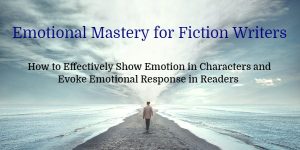How Fiction Writers Can Show Emotions in Their Characters in Effective Ways
Editor Robin Patchen wraps up our examination of Fatal Flaw: # 6 Show, Don’t Tell. Writers often succumb to this fatal flaw of fiction writing, explaining and telling and summarizing instead of showing action as it’s happening. Robin gives some great tips on how writers can show by action and thoughts rather than by relying on describing bodily sensations. Be sure to pay attention to this one! (If you missed this month’s post on this fatal flaw, start with this one here.)
This month, we’ve been studying that famous axiom for fiction writers: show, don’t tell. Today, I’m going to tackle what I think is the most difficult thing to show in our novels—emotions.
If you’ve been writing for a while, no doubt you’ve heard it’s not acceptable to name emotions. Don’t tell us Mary is sad. Show us she’s sad.
Many writers lean on a clever trick to show emotions—they describe a character’s physical reactions to emotions. So characters are often crying, yelling, and slamming doors. Their stomachs are twisting, their hands are trembling, and their cheeks are burning. We hear exasperated breaths and soft sighs. Don’t even get me started on heartbeats. Some characters’ hearts are so erratic, I fear they’re going into cardiac arrest.
So What’s a Fluttering Heart to Do?
I’m poking fun, because I do it too. It’s an easy way to show emotions. But I have a few problems with this old standby. First, these things are so overused, they’ve become cliché. (I know your stomach is twisting at the very thought.) Second, having a character clenching his fists might show us he’s angry, but it doesn’t show us the impetus for that anger. Is he feeling frustrated, slighted, or jealous?
All those—and a host of other primary emotions—can lead to anger. Finally—and to me, this is the most important—showing me your characters’ physical responses provokes no emotional response from me. Your hero might clench his fists, but I promise, mine will remain perfectly relaxed. So you might have shown an emotion, but you haven’t made your reader feel anything. And that, my friends, is the point of fiction—to elicit an emotional response.
Let’s take a look at some effective and not-so-effective ways to show emotion.
BEFORE:
Mary opened her eyes and looked at the clock. Her heart nearly leapt out of her chest. The baby had slept nearly eight hours. But little Jane never slept more than four hours at a time. Something must be wrong.
Not again. Her stomach rolled over when she remembered the last time a child of hers had slept too long.
Mary flipped the covers back and stood on weak knees, forcing herself to her feet despite the fear overwhelming her. She shoved her arms in her bathrobe, slipped into her warm slippers, and rushed for the door. Her hands were shaking so badly she could hardly turn the doorknob. Finally, she got the door open and ran down the hallway toward the nursery.
She threw open the door and lunged at the crib. She peered inside and saw the beautiful pink cheeks of her newborn daughter. She placed her trembling hand on Jane’s back, felt the even breaths, and let out a long sigh. Tears of gratitude filled her eyes as she realized her baby was alive.
Our character is definitely feeling emotions. Do you think I can get the reader to experience a few of them? I’ll give it a try.
AFTER:
Mary opened her eyes and squinted in the sunshine streaming in through the open window. She stretched, feeling more relaxed than she had since . . .
She sat up and looked at the clock. It was after eight. Little Jane had slept through the night. For the first time.
Just like Billy.
Mary flipped the covers back and stood. She snatched her robe from the back of the chair and slipped it on. She wouldn’t think about Billy. The doctor said it wouldn’t happen again. The odds against it were astronomical.
Billy had been nearly six weeks old. Jane was almost two months. It was different this time. It had to be.
She slipped her feet into her fuzzy slippers, ticking off all the ways the situations were different. Billy had been sick. Jane had never even had a sniffle. Billy had been fussy. Jane was nearly the perfect baby, only crying when she was hungry or wet.
She must be both hungry and wet right now, but little Jane was silent.
Just like Billy.
No, God wouldn’t do that to her again. She couldn’t bury another child. She wouldn’t.
She stepped toward her bedroom door, remembering Billy’s skin, how gray and cold it had been. At first, she’d thought maybe someone was playing a mean trick on her. But then she’d lifted him. Seen his face. Those gray lips and lifeless eyes.
Maybe it would have been different if she hadn’t been alone when she’d found his tiny body. Maybe if John had been there. But John had been gone on a business trip.
Mary turned and looked at the empty bed. Her side was a jumble of blankets. John’s side was untouched. He was on a business trip. Again.
He’d rushed home that day two years earlier, assured her it wasn’t her fault. How could she have known?
How indeed? How did a good mother sleep through her own child’s death? How did she dream of beaches and butterflies while her son passed into eternity?
If Jane was dead, Mary would join her. Somehow. She couldn’t live through this again.
She stepped into the hallway and took a first step. A good mother would run, but she could hardly force herself to walk. She inched her way down the hall.
She glanced at the stairs. What if she went to the kitchen, made some coffee? Never found out the truth?
She pushed the thought away and continued past the staircase, paused at the nursery door, and laid her hand on the cold metal doorknob. The clock ticked loudly in the hallway, like a steady heartbeat.
She stepped into the room and approached the crib. And there, sprawled on her back, lay the most beautiful sight she’d ever seen.
Jane’s eyes opened at the sound of Mary’s approach, and she smiled.
I hope you had at least a twinge of emotional reaction to that. I know I did. Please notice, there’s not a single beating heart or trembling hand in that example. Her stomach doesn’t clench, and her eyes don’t fill with tears. Yet she felt a lot of emotions. Did you?
Slow It Down
Counselors tell us that thoughts lead to emotions, and emotions lead to actions. As a writer, you can easily show your character’s thoughts and actions. Readers are smart enough to deduce the emotions based on what the characters think and do. So often it seems writers are in a hurry.
When you have a very emotional scene, slow it down. Let us hear your character’s every thought. Highlight a few details. Show the actions.
Why don’t we write like this? For one thing, it takes a lot longer. My first example is fewer than two hundred words and took me about five minutes to write. The second is closer to five hundred and took nearly half an hour.
Writers have to dig a lot deeper to write selections like the second one. I had to remember what it was like to be a new mother, put myself in the shoes of a woman who’d already buried one child, and try to feel what she would feel. Not comfortable, let me tell you.
And you see a bit into my soul, don’t you? What kind of mother would even consider going downstairs and making a pot of coffee? Yet as I put myself in that scene, I looked at the stairs, and I thought about it. Showing emotions means baring your soul.
Sure, it’s fine to have some lines showing emotions by way of bodily response. But don’t limit yourself to that technique. I hope this example helps you see ways you can elicit emotion in your reader through thoughts and actions.
But showing emotions can pull your reader in and get them to feel right along with your hero and heroine. And isn’t that the goal?
Your turn:
What stood out to you as you read the After example? What lines gave emotional impact?
Want to master the emotional craft of fiction?
Dive into the online course Emotional Mastery for Fiction Writers!
In this course, you’ll be given tools to show emotions in your characters. You’ll be given techniques to help spark emotional response in your readers. What is going to bring it all together for you is practice. Study and practice. And you’ll have exercises in this course to help you put into practice what you learn.
There are two facets of emotion in fiction: conveying what your character is feeling and evoking emotion in your reader. We’ll look at these two facets separately and in de pth. Yet, they are intrinsically connected.
pth. Yet, they are intrinsically connected.
Emotional mastery requires writers to set up the dynamics of a scene in such a visual, textural way that readers can’t help but feel what they are meant to feel. Understanding that emotional mastery requires a twofold approach—the emotional landscape of both the character and the reader—is the first step.
Want to learn how to become a masterful wielder of emotion in your fiction? Enroll in my new online video course, Emotional Mastery for Fiction Writers.
You’ll get lifetime access to all the videos and more than three dozen downloadable assignments. And with a 30-day money-back guarantee, you have NOTHING to lose by jumping in. Sign up NOW.
This course will challenge you to become an “emotion master.” Are you ready and willing to go on this journey deep into emotional territory? If you want your characters to move your readers, take the plunge!
Listen to my discussion on how to show emotion in characters. There is so much to this topic!












I found this article very helpful. It’s a delicate balancing act to slow down the action enough to heighten the emotion but not so much as to cause the reader to skip through the scene because they want to get on with it. You’ve given some good examples for doing just that. As always, another great piece of advice, C.S.!
If you think the reader might skimp over the scene. You might want to re-write it. Every scene in a story has to build up emotion and anticipation to progress head on from scene to scene.
I absolutely loved this article, and I 100% AGREE with your logic. Thank you for sharing!
Thanks!
One of the best posts I have read on the subject. Thank you for the great example!
Thank you!
Great advice, Robin!
Robin,
You’ve gotten to the ultimate solution here: the truly effective approach is to describe *why* the person is feeling what he or she is, rather than the exterior symptoms.
Thanks, Curtis. I definitely think that’s a big part of it–at least one element of showing emotions. Of course we couldn’t do this with every single emotion–imagine 500 words to replace every frown. But when the emotions really matter, I think they’re worth examining.
This is one of the best articles I’ve read on this subject. You really bring it to life with your example.
Thanks! I’m glad you think so.
I’ve been often critiqued that my characters must have more emotion by showing their facial expression and bodily response to situations of distress. I can fully understand from your example how much I have dismissed all these factors by summarizing their feelings. Thanks for such a vivid example of how to convey feelings without putting a label on them.
Glad it helped. I think sometimes, we believe that the physiological reactions are the only way to show feelings, but personally, I’d much rather know what’s going on in people’s heads. Ever look at someone and think, “What is he thinking?” What’s on their face doesn’t tell us what we really want to know.
“If Jane was dead, Mary would join her. Somehow. She couldn’t live through this again.”
This line stood out to me. It puts the reader in the state-of-mind the character is in at the moment. Thanks for the article.
Kind of depressing, though, isn’t it? I’m glad it stood out.
This is a great article! You’ve really “shown” the difference very effectively 🙂
Great article! I like the contrast between showing exterior vs interior. The other trick is doing this with Deep POV.
To answer your question…I felt every bit of what the mother was experiencing. You’re an extremely talented writer. Slowing it down is so important, yet since it’s time-consuming I find myself breezing over it, too. During my second drafts I’m often horrified at the heart-fluttering, weak knees, and shaky hands in my first draft. Using subtext instead of body cues is what I’m working on now before I send my ms back to the editor. Stellar post!
My first drafts have a lot of breathing–sighing, blowing out breaths, holding breath. I think my characters might suffocate if I don’t show them breathing. 🙂 The key is to leave that stuff in draft #1.
Thanks, Sue!
nicely shown
This is very helpful. Thank you for posting this.
I do have one question though. Do you ever feel like you can overdo the inner dialogue? For example, Kurt Vonnegut once said that every sentence should either reveal character or advance the plot. How do you decide how much inner dialogue is revealing character and how much is just killing your pacing?
Is it just experience and a good ear?
Genre plays a big part in determining this! I have read suspense thrillers that are hugely internal thought, packed full of worrisome thoughts to ramp up the emotional tension. Getting in close to what a character is thinking while afraid can make the reader feel that fear. For other genres, and personal author writing styles, such as Cormac McCarthy’s, you’ll see almost no internal thoughts at all. Internal dialog can both reveal character and advance the plot, so Vonnegut’s sage words apply here as well. Best is to study other great novels in the genre in which you are writing and note (highlight?) all the lines of internal dialog and their content to see just what that amount is.
That’s great advice. Thank you!
That’s a great question, Paul. Susanne’s advice to study other great works is great.
You certainly wouldn’t want to have this much internal dialog all the way through a book. It needs to serve a purpose. In this case, we want to get the reader emotionally invested in the scene, and the best way to do that is to let us see what the character is thinking. But if the hero is deciding between a bagel or a donut, you wouldn’t want to show us his calculating the calories of each. That would get old fast.
At first, it can feel unnatural, but I think the more you write, the more intuitive it becomes.
This is a great article. I know I’m certainly guilty of getting lazy and writing scenes as I see them instead of delving into the character. I’m about to begin revision, and I can already think of places I need to expand and deepen. Thanks for the insight!
So glad it helped, Victoria. Good luck with your revisions.
This is the best example I’ve seen on this subject! I’m so glad I found it. My stories end up being like the ‘before’ and I never really liked it. It felt like something was off. You’ve really opened my eyes. I tried this on a scene I was working on and now it sounds much better! Now I must look for more tips and keep on writing.
All I can say is thank you.
Shalom aleichem,
Patricia
In the ‘After’ example, it was her questions that showed her doubts and her fears. That gave me the emotional response.
A good observation, Mawr. Thanks for stopping by.
I like how you demonstrate internal thoughts in third person. Many writers want to switch to first person in italics. To me this loses the continuity of the story. So right, body movements and facial expressions keep the reader on the outside of the character. Your before and after is so helpful! Thank you!
Thanks! Glad you found it helpful.
Wow. This has helped a LOT! I’ve had more compliments on one scene that I did this with, but didn’t really know concrete what I was doing. The difference was I put myself there, slowed down, and actually physically moved the way the character would, felt what she would have felt. It was amazing. Thank you so so much for sharing!!
Glad this helped you! Being aware of this can really improve the emotional impact of your scenes.
So glad it helped, Kelly.
Excellent article. Always eager to collect knowledge like this. Thank you.
This is great, but it bothers me slightly. This “slow” method of writing matches the woman’s trepidation and reluctance to learn the truth. But often emotions are felt, and acted on in an instant, and I’m rather uncomfortably aware of the fact that describing something in detail can turn a couple of seconds into a page or more.
That’s true. Sometimes it’s appropriate to slow down a moment. Sometimes, it’s not. You have to use your best judgment.
This opened my eyes to why writers have to pace a story. Just earlier, I was editing and rewriting parts of my story. It took hours, but it was worth it in the end.
I think the line that stuck out to me was, ‘How did she dream of beaches and butterflies while her son passed into eternity?’
I don’t even know how to describe why I like this line so much. I just do.
Thank you for this wonderful article. Otherwise, I wouldn’t have completely understood why pacing and emotions are so important in writing.
Thank you, Mini, for your response. I’m so glad the article worked for you. I loved that line, too. I need to find a place to use it in a book!
Great article. This is what I need to improve my writing. In your example it might go too long and it gets repetitive with the woman’s fears. If it was a tad shorter might be better. Just a thought.
P
You may be right. Thanks for the feedback.
Great article. Is it say that I thought the first version was good? The second version elicited a deeper emotional experience, but I thought it told a lot. I can’t seem to find that line. The first version was active, but it did have the typical overdone descriptions. Then I read other books, and I see all sorts of contradictions from what I learn on writing sites. Sighing, knees wobbling, lips curling, eyes narrowing, jumping back, staring. I thought relying on action was great! I thought I found it….back to the drawing board.
Susanne gives good advice. I don’t have an answer. First pass, my characters do a lot of breathing–sighing, heaving, inhaled frustrated breaths. It’s as if I fear they’ll suffocate if I don’t have them breathe a couple of time son every page. 🙂
My characters’ eyes are lighting up all the time, and I have character beaming. Subject verb direct object. How do I break from this tyranny? lol
Maybe pull the plug?
the best way!
im thankful to u
Excellent article — successfully writing emotion is something I struggle the most with, this is a great help.
Thank you!
Excellent post. I want to write with more emotion. Thanks for the great example.
gramswisewords.blogspot.com
Glad it helped, Maz!
As a young writer I constantly have the “show don’t tell” philosophy thrown at me and I have read countless posts telling me that “if you’re telling the emotion even just a little bit rather than just completely showing it, you’re doing it wrong” blah blah blah, you get the picture.
So to read this post has definitely changed my perspective on the delicate handling of emotion.
You have demonstrated, in my opinion, a perfect balance of show and tell, so that I haven’t just been informed of the character’s feelings, their responses to traumatic events, and their life-but rather I’ve been whisked right into the character’s life to watch it all unfold.
So many books I’ve read have just informed me that “oh the character is sad” as if the author is just like, hint hint wink wink-this is the part where you, the reader, should be sad too. Preferably crying over my character.
Or they just say, this person is so angry they’re gritting their teeth.
Like be angry at the villain because my character is angry at the villain.
But I feel nothing, because they’ve shown me how the character is feeling but they haven’t grabbed the reins of my emotions and MADE me feel for the character.
If you get what I mean haha
Anyways, sorry for the long comment but yeah, I just wanted to say thank you for this article-it was incredibly helpful 🙂
Glad it helps! You might like to read more about that in our 12 Fatal Flaws book. I do a whole PowerPoint workshop on this topic. I think it’s so much more effective to show what a character is thinking to evoke emotion.
I’m so glad you found the article helpful, Hannah! I know what you mean. There’s a big difference between showing an emotion and evoking an emotion. It’s much harder to do the second.
Thank you so much!! I was really struggling with the concept and I tried some other articles but this one helped the most by far. Once again, thank you so much!!
I’m so glad you found it helpful!
“How did she dream of beaches and butterflies while her son passed into eternity?” This line really got to me. I think because I would think something similar. How could I not know? How could I laugh or dream and live while someone I love is dying?
When my mother died I was at work in the stock vault. I had forgotten my phone on my desk and when I got back to it my coworkers were looking at me and saying my phone had “blown up”. They all knew my mother was sick in the hospital dying and when I got back to my desk they all knew what I did not, that she had died while I was in the vault, chatting with my colleagues. So yeah that line got to me and brought back that memory.
Perri, what a difficult memory for you that must be. I’m sorry to have brought it back. On the other hand, if the goal is to elicit an emotional response, I suppose I did manage to do that. Thank you for the note.
No, I will never refrain from telling emotions directly, and I will not read fictions which shows emotions instead of telling. Showing is necessarily ambivalent and results inevitably in incomprehensible drivel.
Interesting take on it, Klaus. Thanks for the note.
This opened my eyes in so many ways. I am deeply grateful to you for the simple solution to a complex issue in writing… Making an old emotion sound fresh as though it is felt for the first time is simply not easy. This was easy to read, and it brought feeling immediately.
Thank you
So glad you found it helpful, Charlotte!
I’m sorry but the first part was the right part for me.
The second was way to long and I lost interest. I feel this is the problem often. To each their own offcourse, can’t please everyone 🙂
Damn, I was thinking the same! I enjoyed the first part so much better than the emotionless descriptions about how she had to bury Billy. The stomach rollover literally gave me a melancholic feeling which didn’t happen with “God wouldn’t do the same to her”
Thank you for this article. I would like to study some of the great novels for expression of emotion. Any recommendations?
Amazing advice! This is the toughest part of creating a flesh and blood character for me. How would u apply this to first person voice?
You can just change “she” to “I” and it’s the same thing, basically. There really is no difference between first person and third person when doing deep POV.
Yes, I cried. This is the most effective article I’ve ever read on the subject of “Showing” and I recommend it to writers often. Please, never take this post down!
I didn’t mean to make you cry, J.D.! 🙂 I’m glad you found it helpful. God bless!
Still taking this article in. Have printed it off for easy reference and example. Thank you for posting this.
Stephen King does it well, by getting the protagonist to get involved deeper and deeper into an emotional state which reach a tempo unbearable.
My pleasure, Virginia. I’m glad you found it helpful.
Some good points in the way you show emotions. “Her heart nearly leapt out of her chest.” This one looks too cartoony, and nearly is an adverb [use prohibited by good writers I am told.]
The occasional adverb is acceptable, but you’re right, the line is cartoonish. That’s one of my issues with all the physiological reactions to “show” emotions–they’re exaggerated, often to the point of becoming ridiculous.
Wow, this is good writing. Hair literally stood on its ends, as I read the second rendering, even though I knew baby Jane was safe from reading the first version.
Amazing bit of writing. Thanks for the article.
But isn’t this kinda too intense for a reader? I can read the occasional paragraph like this but as a reader, I would be a nervous wreck if I had to read an entire full length novel written in this style.
Sometimes, maybe the tell is much better than show – like those ‘implied’ scenes in movies, rather than an explicit scene.
Would you recommend that a writer sticks to this POV for the entire novel or only use this occasionally? And if the latter, what kind of scenes might call for this?
Hi Badri, of course you wouldn’t have this intense a moment in every single scene in a novel. Novels should have low-energy and high-energy scenes, low- and high-action scenes, low- and high-emotional scenes. As far as POV goes, that applies to the viewpoint: whether you are in first, second, or third person. I’m not sure what you are asking, but if you mean going into deep or intimate POV, that’s a style choice and would be consistent throughout the novel.
Like CS said, not all scenes are this intense. The point is to show emotions through thoughts and actions rather than through physiological responses. So if your character is feeling happy, show the happy thoughts. If she’s feeling angry, show angry thoughts. It wouldn’t be appropriate to get this deep into every emotion, though. That could be cumbersome.
I am a very later bloomer in writing (and reading as well, I’m embarrassed to say). When I would read anything that invoked emotions as a child or young adult, I could not handle it (due to many different things going on in my life). But I am now at a different place and I am finally discovering how much I enjoy reading, well, I really mostly enjoy reading that makes me feel the emotions like your posting did.
In your first take I was thinking, oh get over it already lady…I never really liked babies anyway, we all gotta die sometime…etc… (lol, exaggerating here of course). But in your revised version, I was on tears and on the edge of my seat, thinking, that poor mother…that poor little baby…no no no…nothing can happen to that beautiful little baby…
I was shocked at the difference of my own response.
I have contemplated trying to become a writer and this posting has inspired me so much. This is now my goal – to write something that makes a reader feel this much emotion. Thank you sooooo much for sharing this.
The author of the article did a magnificent job conveying her lesson. I would offer a little insight into child loss, however. A parent never gets over losing a child. It will not happen, as a part of their heart has been torn away, outside of the natural order. Even though you may not know the experience, please do not belittle it, or those going through it. Good luck with your writing, as you walk this path with us.
I understand the concept behind it the “after”, but I have woken up before worried my baby was dead because she slept through the night… and the last thing I would have done is slip on my cozy slippers. I definitely didn’t take 10 minutes to think about if she could be dead before checking on her. So in reality — the before felt a little closer to truth to me, it was just felt a little extreme on the visceral emotions. Maybe it is just me.
Thank you for the article, even though the example didn’t resonate with me, it was an excellent example to get the point across.
I’ve been writing novels for over a decade. Finally,I understand it is the process rather than the physical manifestations of an emotion, alone, that conveys emotion to the reader! Thank you for such an intriguing insight, and thank you to my editor Beth Terrell for steering me to your blog.
Glad you arrived here! Be sure to check out my online course, too, as it goes way deep with 40+ passages examined!
So glad you found the post helpful, Jennie!
What I was able to read of the AFTER piece was wonderful. Unfortunately, the situation hits far too close to home for me, and I couldn’t finish it. You absolutely nailed it, though. The first one did not bring forth the same emotion in me the second one did. Further, the emotion built as you advanced, thus my reaction. Yes, I shed a few tears before I was able to write this reply. Thank you for this article, the insight and the advice. I will take this to heart, as I continue learning the craft.
Thanks for sharing those sentiments. I’m sorry this was/is painful for you.
I’m sorry for raising these painful memories for you. Thanks for the comment. God bless you.
Please, don’t be sorry. It is a part of life for parents who have lost a child. However, the way you wrote the piece was marvelous. That it was so powerful is a testament to the example you built. Well done. It is a wonderful lesson.
To answer the question on what stood out the most, I would say it was the last sentence. It was the baby smiling that gave me the strongest emotional response. Starting to read the text, I didn’t really “plan” to get a tear in my eye, because I find it all too easy to shield myself from the sad stuff, even though I would like to feel more directly. But fortunately, the moment of beauty and joy in the end got to me. It took me by suprise and managed to break through my shield. I will try to incorporate this in my own writing.
Fantastic article and it helps me a lot. At the point when I write, I attempt to recollect what I feared or what was terrifying to me and attempt to place those sentiments into books.
Omg! I loved this, thank you so much for sharing.
The same old story, to show emotions with your characters. SHOW don’t TELL!!!
Excellent post. It is feasible to submit no mix-ups and still lose. That isn’t a shortcoming; such is reality. This article really helps me a lot. Thanks for posting.
This was a very engaging post. It has provided me with new information and now I have a better idea of how I can represent emotion within a fictional character. Also, the example that you provided was written so well! You have given me so much inspiration and I can tell that you are a very hard worker and are dedicated to what you do. Thank you so much.
You’re very welcome!
I’m so glad, Elise, that you found the post helpful! God bless you and your writing.
I think I’m missing something. Can anyone please clarify the differences between the two examples because they both use body language to indicate emotions. If anything, the before seems better because it includes body language *and* internal reaction. The after only uses body language.
The article explains what the differences are and why using thoughts is so much more emotionally effective than showing body language. The After version uses no body language (physical tells). The thoughts are what get readers to understand and empathize with characters.
Neither the Before or After work. As for the Before, who writes like that? Must be a really rank beginner. As for the After, I spent the whole time while reading it thinking, “Not only is this ridiculously long, but no panicked mother is going to take the time to slip into her robe, put on her slippers, and have a coherent thought-stream going through her head about what happened to her other child.” No. She’s going to dash to her baby. Time for these other thoughts–or rather, an abbreviated version of them– can come as she’s cuddling her child. Perhaps better yet, put these kinds of thoughts in an earlier chapter, as background material. Then she can just fly out of bed and run to her child, and some further reflection can come when she’s found the baby safe. This is a time to act, not reflect.
Thanks for your comments. Everyone is different, and depending on the kind of character we create, they will respond differently. I would be exactly like that second example. I did similarly when I woke and hadn’t heard my baby cry at night. I put off going in as long as I could. Of the hundreds of writers I’ve shared these examples with in workshops, 99% agree with the second one as the more moving, effective, and believable example. As I said, everyone is different. But it’s all about your character–her past, who she is, etc. You might try to write this scene and then run it by critique partners and see what their response is to the way you present the character. It might be enlightening!
As a fairly new writer, I have a question that might seem silly, but it’s one that I’ve often debated. I have a tendency to spend way too much time on the scenes as I write them. I’ll go back, and back again, until I feel like it’s perfect … until I don’t. At this point I am 15,000 words in and have probably spent enough time on the chapters that I have done to have completed two novels.
Experienced writers, keep telling me to just write, and finish the first draft. Do you feel it would be appropriate to draft scenes like example #1 and then come back to add emotion like example #2 during the second draft? After reading your article, I have found myself going back to my completed chapters once again, and looking for opportunities to add emotion. I don’t feel like this is productive. Any advice?
I hear you! I constantly rework and edit as I go along, and usually by the time I complete a draft, it’s finished except for proofreading. However, I always push to make progress. If you set a goal to write at least one scene, however rough, every time you sit down, you can give yourself permission to go back and noodle with whatever you’ve written–that scene or a prior one–to polish it more. But the point is to make progress. If the problem is you are “pantsing” and don’t have a strong outline such that you don’t know what your next scenes will be, that can cause a lot of procrastination. Work on a scene outline (with me!) and get it tight. Then it won’t create a barrier to you getting those next scenes written. Usually redoing scenes over and over is due to not feeling confident where the story is going 🙂